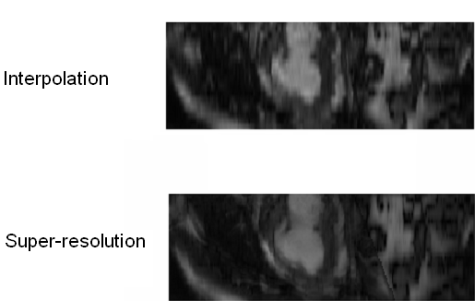(Sami ur Rahman)
Super-resolution reconstruction of cardiac image data
In cardiac MRI, typically short-axis (SA) slices are acquired and the analysis of the volumetry and cardiac motion patterns is based on these images. However, cardiac MR image data is highly anisotropic: the slice thickness is several times greater than the in-plane resolution. For achieving good segmentation and analysis results, it is desirable that the image data is provided as isotropic data, where the resolution in slice-selection direction is as good as the in-plane resolution.
If in addition to the SA slices long-axis (LA) slices are acquired, both data sets can be combined to an isotropic high resolution (HR) data set. Existing approaches compute such data by taking the mean value of both, SA and LA data sets, into account. In contrast to that, we apply a super-resolution reconstruction (SRR) technique for obtaining that high-resolution data set. We reconstruct a uniform resolution volume grid of 1.5 mm voxel size in all directions based on the two input data sets with a resolution of 1.5 mm x 1.5 mm x 8 mm. This considerably improves the image quality compared to a simple averaging technique.
S. ur Rahman and S. Wesarg
Combining Short-axis and Long-Axis Cardiac MR Images by Applying a Super-resolution Reconstruction Algorithm.
In: SPIE Medical Imaging 2010: Image Processing. Proceedings Issue. Vol. 11, No. 33. Bellingham: SPIE Press, 2010.
S. ur Rahman and S. Wesarg
Upsampling of Cardiac MR Images: Comparison of Averaging and Super-Resolution for the Combination of Multiple Views.
In: 10th IEEE International Conference on Information Technology and Applications in Biomedicine. Proceedings. IEEE Computer Society, 2010




